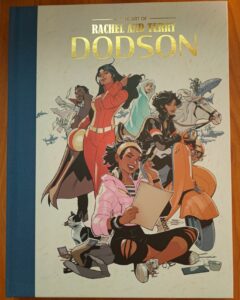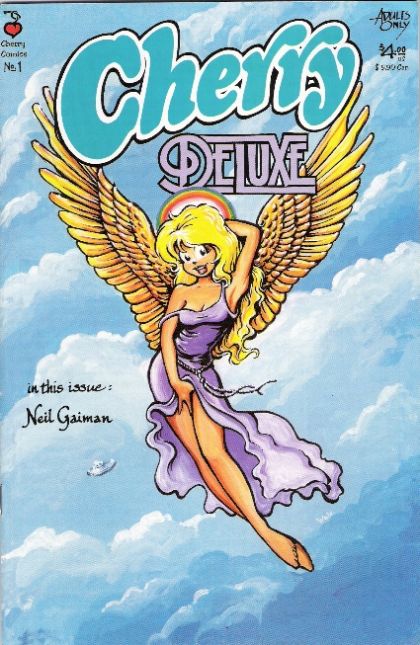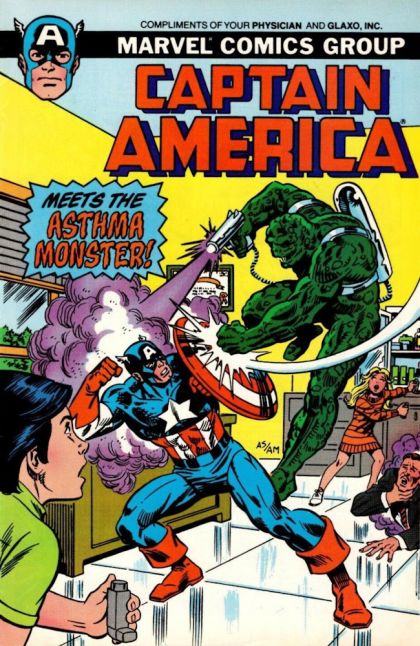Unbagging Roxxon Presents: Thor
Roxxon Presents: Thor
#1A

Greg Land Regular
Release: Apr 17, 2024

Creators
| Writer | Al Ewing |
| Artist | Greg Land |
| Cover Artist | Greg Land |
| Cover Colorist | Frank D’Armata |
| Penciller | Greg Land |
| Inker | Jay Leisten |
| Colorist | Frank D’Armata |
| Letterer | Joe Sabino |
| Editor | Wil Moss |
| Editor in Chief | C.B. Cebulski |
Yet one thing more do I ask of thee–for the All-Father hath raised no bums. Thou must get a haircut, my son. And a job in tech.
The Immortal Thor has been an interesting book in that it feels as if it’s taking a “back to basics” approach tot he character without actually being regressive or really even bringing back any of “the basics” at all. It’s very much building on the foundation laid by recent runs – particularly Jason Aaron’s – and the status quo is very far from what one might consider to be classic Thor.
But while he is now the All-Father and doesn’t transform into Donald Blake – or even throw out any thees and thous – the God of Thunder contained in the pages feels familiar.
Which is quite a contrast to the Thor we find in this special one-shot which flows from the events currently underway in the regular monthly book.
To recap: Thor’s mother, Gaea, the Goddess of Earth, opened a previously-closed gateway to the realm where her Elder God siblings live. These Elder Gods are to Asgardians as Asgardians are to humans, and one of them very nearly ended all life on Earth. All human life, anyway. Thor confronted his mother to find out why she did this, and the reason, of course, is why do you think? Humans are the worst!
This conversation inspires Thor to return to a battle he once engaged in back during the Aaron run that kind of fell by the wayside as other things occupied his attention: putting an end to the destruction of the planet being caused by Roxxon.
It’s generally redundant to say “evil corporation,” but Roxxon is more evil than most. Roxxon, despite what its PR people might tell you, is explicitly evil in ways that most real-world corporations could only dream of being (well, except maybe Meta). It’s the platonic ideal of evil corporations.
Its CEO, Dario Agger, is a minotaur, and his only goal in life, as he’s stated to Thor, is to see number go up, with his ultimate plan being to render the world unlivable – with the exception of domed communities, owned by Roxxon, that the remaining population will have to pay a premium to inhabit.
Agger has actually been stepping up his efforts to ruin the Earth in order to drive Gaea to take action, which will only serve to accelerate his plans.
He also, of course, has plans to prevent Thor from interfering.
One of the concepts that The Immortal Thor has explored is the power of story and how stories can shape reality. We got a demonstration in a recent arc in which Loki – who is now the God of Stories – told Thor a story about an adventure the two of them undertook while they were still young, in the days before Thor became worthy.
Unbeknownst to either, this telling was being observed by Agger with the assistance of Amora the Enchantress, who has hatched a scheme – as she is wont to do – to ensnare the Thunder God.
As an aside, this is an example of going back to basics, as it’s been quite some time since we’ve seen the Enchantress hatching a scheme, and also because we see Skurge the Executioner, after having dabbled in being heroic, returning to his villainous roots. Or at least returning to his roots as a simp for the Enchantress.
Marvel Comics itself exists within the Marvel Universe.
The Marvel Comics of the Marvel Universe publishes comics that depict the real-life adventures of superheroes. In most cases, they have acquired the rights to do so, having signed licensing agreements with groups like the Fantastic Four and, more significantly for this story, the Avengers.
(Traditionally, they did not have deals in place with Spider-Man or the X-Men but believed they were within their rights to publish comics about them anyway due to the outlaw status of those particular costumed adventurers.)
Thor, as an Avenger, is a signatory of one of those licensing agreements.
Stories have power. Money has power.
Roxxon has money. Roxxon can use money to buy stories.
Thus, Roxxon acquired the licensing rights to Thor’s stories, and with a little help from the magic of the Enchantress, Roxxon can now use the power of story to reshape Thor’s reality.
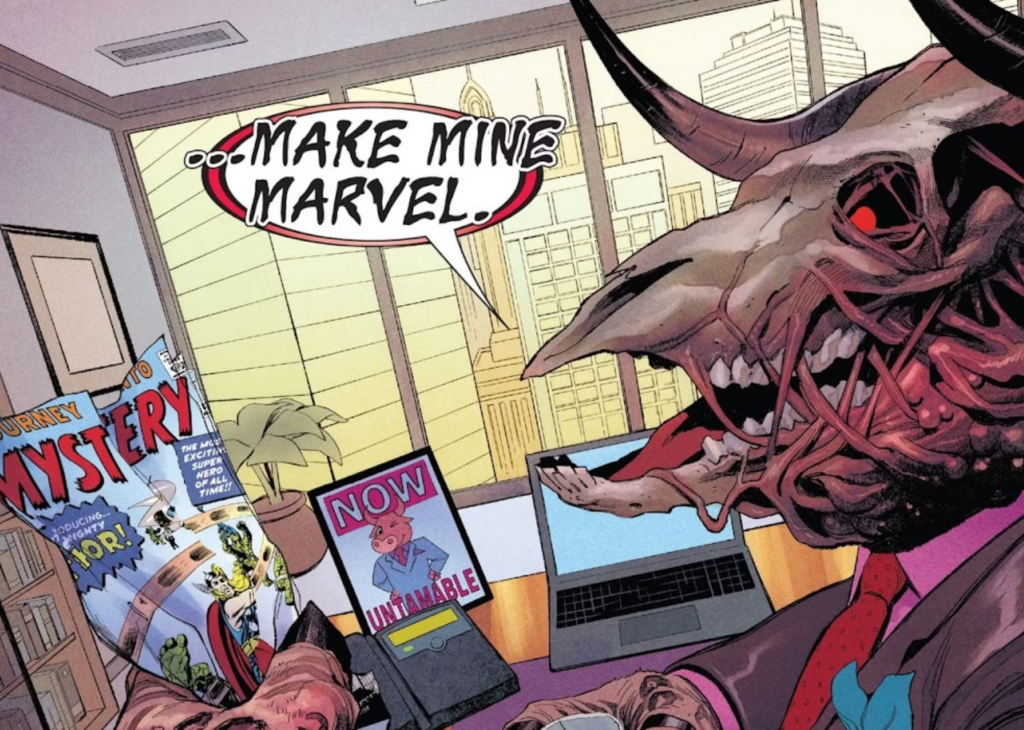
…wait.
Which brings us to this one-shot.
The plot is pretty straightforward. After having learned humility in his time on Earthgard – there’s a recurring gag in which we get footnotes explaining that “Earthgard” is “Earth,” a play on the actual “Midgard/Earth” footnotes from Thor comics – Thor finds out that he wasn’t supposed to learn to be humble at all, it was just a test of loyalty. Gods shouldn’t be humble! Odin commands Thor to get a job working in tech so Thor takes on the alter ego of “Chad Hammer” and goes to work for Roxxon as an “influencer in the field of A.I.-based hedge funds.”
(We never actually see him working as Chad.)
After returning to Earth(gard) from a recent adventure, Thor gets in his Thor-Truck – eventually; it’s a tricky process, as there are no door handles – and heads to Roxxon.
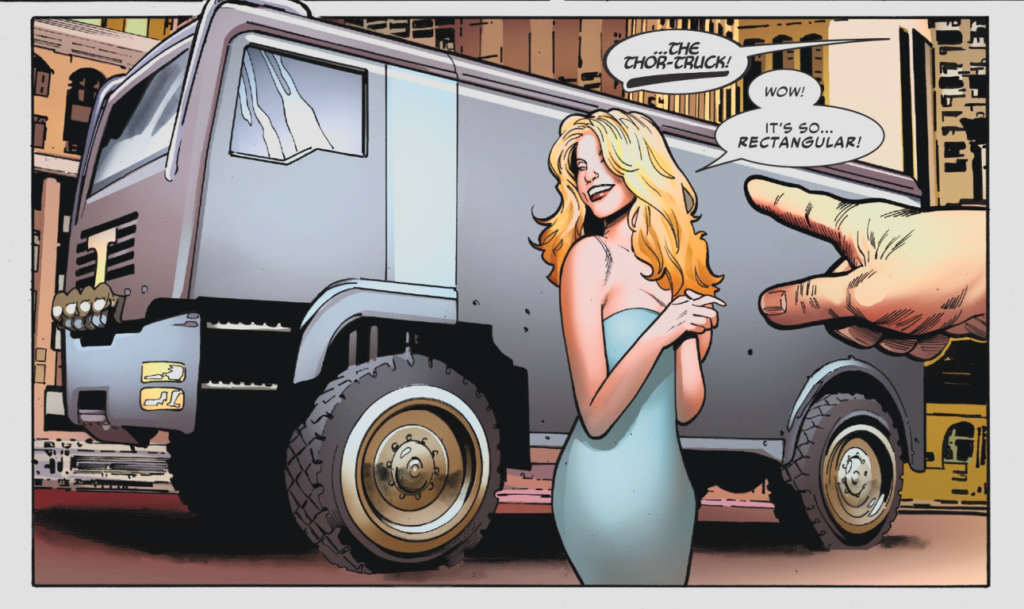
However, he’s greeted by a very unwelcome surprise once he arrives: protesters!
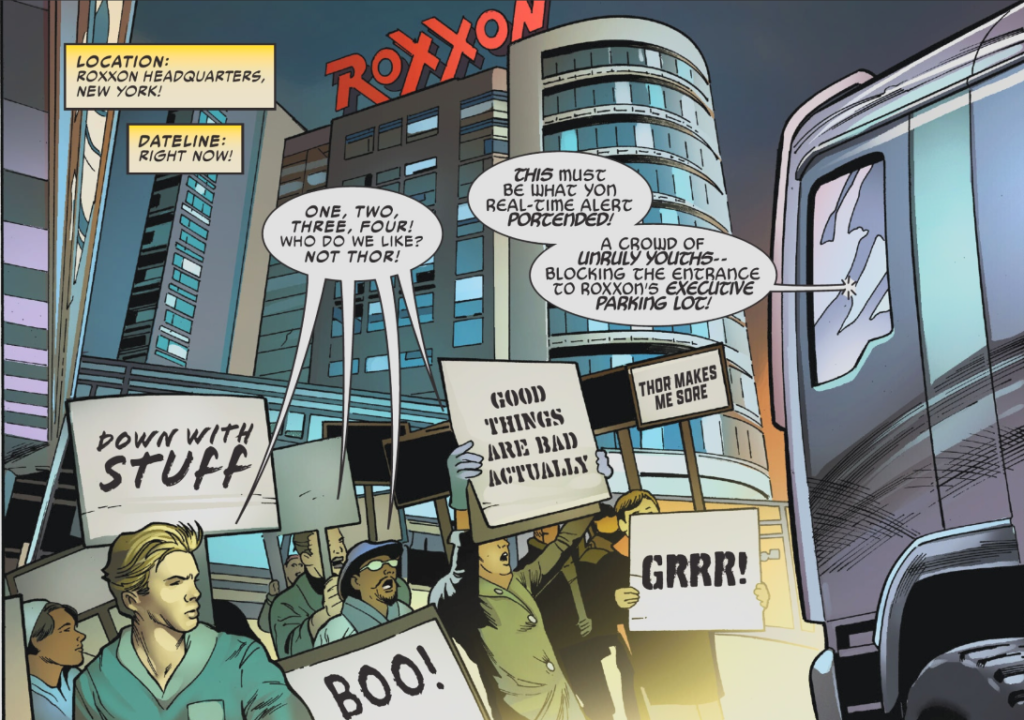
Thor tries to reason with them, but they take things too far by throwing a banana peel at his Thor-Truck, so he calls on the lightning to force them to scatter.
The banana peel can’t damage the Thor-Truck, but the idea that young people might not think he’s cool does damage the Thunder God’s heart.
Disheartened, Thor meets with his friend the Minotaur to get a sense of perspective and a pep talk.
The Minotaur explains that the kids who are protesting against pollution and climate change aren’t completely evil, just mostly evil, and they don’t understand that while the Earth might be healthier without Roxxon’s product its life wouldn’t be worth living.
The Minotaur asks Thor to find out what’s really going on.
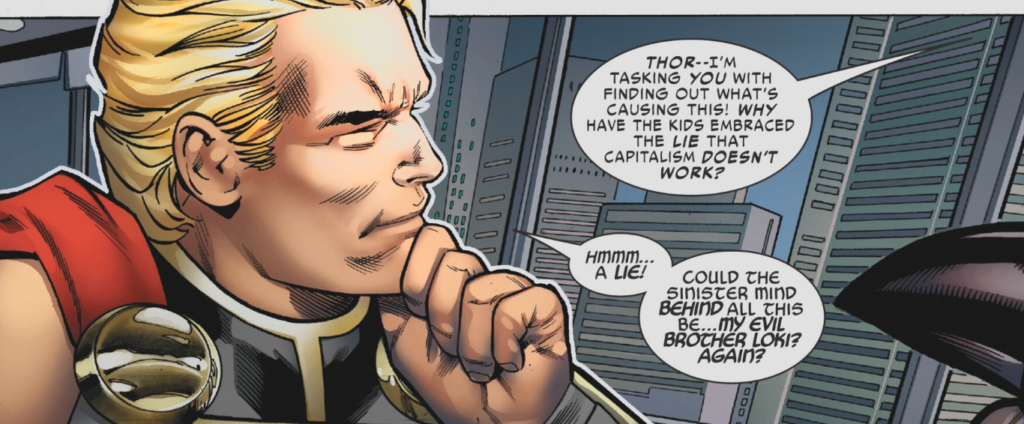
We cut to Loki meeting with the young fools and “idle scroungers who’ve never done a day’s work” he’s deceived into believing in things like climate change being real.
He prompts them to get to work on making ten-hour long video essays about climate change and about Thor being uncool, all the while plotting to destroy not only his brother but the stupid young people he’s conned into believing that it’s illegal for Roxxon to dump toxic waste in endangered wetlands (a footnote informs us that it won’t be, pending a Supreme Court decision).
Next we check in with Thor’s pals Skurge the Executioner and the Enchantress who are enjoying a day at the beach. Well, Skurge is, anyway, but the Enchantress has other things on her mind.
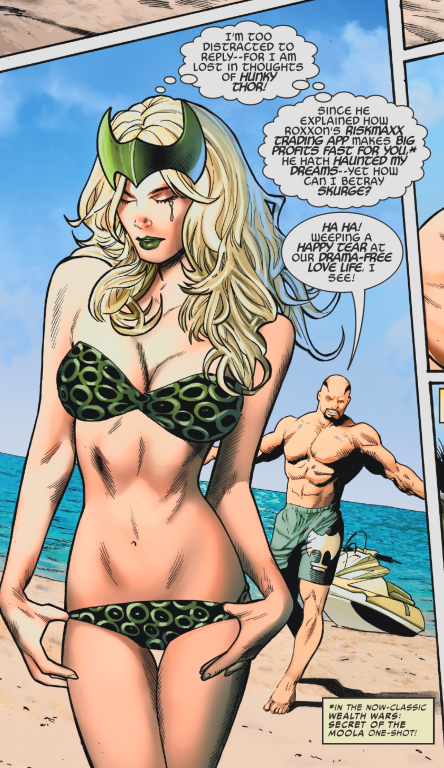
Despite the goofy, parodic nature of the comic – or comic within a comic – this bit also feels like a back to basics moment, as it’s a pretty good encapsulation of the nature of the dynamic of the relationship between the two villains and the ultimate motivation of the Enchantress. Just minus the stuff about Roxxon products. I’d guess this is a bit of her reality bleeding into the story the Enchantress helped create.
Heimdall shows up to tell them that Thor is about to show up to ask for their help just before Thor shows up to ask for their help. (This seemed to mostly be for the purposes of making a reference to the relationship that Heimdall and the Enchantress once had. Perhaps another instance of the Enchantress’s own thoughts finding their way into the story she helped weave.)
With the help of his Roxxon A.I. assistant, Thor determines that Loki is indeed behind this nefarious anti-Thor scheme, and the friends go off in search of the evil fiend.
They immediately find them even though Loki had managed to hide their location from Heimdall’s all-seeing eyes because he could not hide the stink of the unwashed protesters from Heimdall’s all-smelling nose.
However, Loki uses his powers to cast illusions that cause Thor’s friends to seemingly desert him, while Thor himself is unable to discern what’s real and what’s not.
Fittingly, as the Roxxon Thor is lost in illusion, we cut to reality and find the real Thor just as confused as his four-color counterpart.
In this brief interlude, Agger explains to Thor what’s happening.
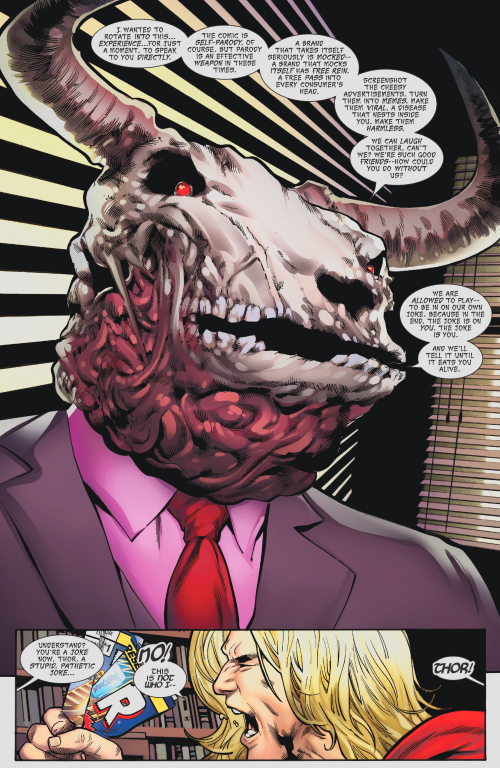
Back in the comic, Thor’s friends return with the key to defeating Loki’s illusions: an Apple Vision Pro headset a pair of Roxxxpexx alternate-reality goggles.
This allows Thor to see Loki in 8K clarity and strike him with a bolt of lightning while Skurge calls in a drone strike to deal with Loki’s followers.
With that taken care of, Heimdall brings Loki back to Asgard for a round of torture, and a still-troubled Thor asks his father if there’s a chance that the kids were right.
Odin tells him that there’s someone there who can answer that question for him and he sees that his pal the Minotaur is there, as is Thor’s mother, Gaea herself.
Gaea assures him that if there actually is any need for change it has to come slowly, and after all, the Earth shouldn’t be too nice as that would destroy humanity’s entrepreneurial spirit.
Then the Minotaur gives “Chad Hammer” an off the books bonus for the good work he did.
The end.
It’s a fun little story, littered with funny bits such as the frequent references to “Earthgard” – in one case, someone says “Earth” and gets a footnote that appends the “Gard” – and the prominent product placement for items sold by Roxxon.
In some ways it felt kind of like the Marvel magazine parodies and swimsuit specials of the early ’90s, particularly thanks to the couple of full-page ads for Roxxon and Roxxon products that appear within that were similar to the fake ads featured in those specials.
The comic is, as Agger says, deliberately silly, as the whole point is to turn Thor into a joke, to use the power of story to take away his power and prevent him from interfering with Roxxon’s goals.
And of course there’s the real world commentary sprinkled throughout, with the Thor-Truck being an obvious parody of the Cybertruck (which itself seems like parody), and the depiction of young people as being exactly the sort of feckless, lazy, unwashed masses that the people they’re protesting against insist they must be, which is exactly what a corporate propaganda comic would do.
There are also the various cartoonish ways in which Roxxon is evil that don’t seem as cartoonish as they should, and little touches like the A.I. assistant being little more than a digital Magic 8 Ball.
I also liked the old-school use of notes to inform the reader that the story continues after a certain number of ad pages.
I’m glad that Ewing has decided to return to the Thor vs. Roxxon storyline, as it provides fertile ground for conflict, a battle between the old gods and the new. What can all of Thor’s godly might avail him against the power of a corporation?
I also especially appreciate the cleverness of turning the Marvel Comics licensing agreement against Thor. It’s always fun when there are stories that involve the in-universe comics.
As for the art…say what you will about the work of Greg Land, but I can’t think of anyone who’s more perfectly suited to draw a comic like this.
I’m interested to see how this plays out in the regular book – I suspect that in the interlude in reality the voice that was trying to get through to Thor was Loki – and I’ve been enjoying what Ewing has done there so far.
This was a fun diversion, but I’m ready for the main event.

Born and raised in the sparsely populated Upper Peninsula of Michigan, Jon Maki developed an enduring love for comics at an early age.
